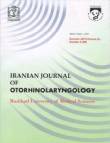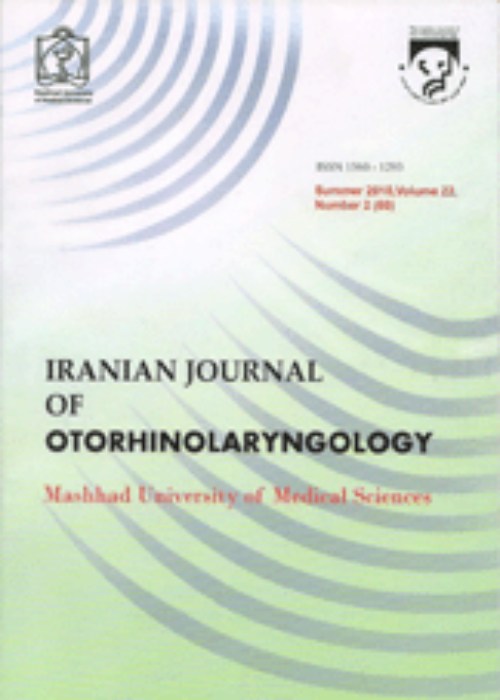فهرست مطالب

Iranian Journal of Otorhinolaryngology
Volume:35 Issue: 6, Nov-Dec 2023
- تاریخ انتشار: 1402/08/10
- تعداد عناوین: 6
-
-
Pages 295-301IntroductionTartrate-resistant acid phosphatase (TRAP) is an acid phosphatase metalloprotein enzyme expressed in osteoclasts and is related to bone resorption. The molecular mechanisms involved in the different behavior of odontogenic keratocysts have not yet been fully elucidated. The purpose of this study was to compare TRAP expression in odontogenic keratocysts, radicular cysts, and dentigerous cysts.Materials and MethodsIn this cross-sectional study, we selected 60 samples, including 20 cases of each one of the odontogenic keratocysts (OKC), radicular cysts (RC) and dentigerous cysts (DC). The samples were stained with TRAP monoclonal antibodies using immunohistochemistry. The data were analyzed using the Chi-Square and Kruskal-Wallis tests.ResultsIn this study, TRAP expression was observed in the lining epithelium of 50% of OKC cases and 5% of RC cases, while it was negative in the lining epithelium of DC. This difference was statistically significant (p<0.001). Moreover, the TRAP staining intensity in the lining epithelium had a significant difference between the groups (P<0.001). TRAP expression in the connective tissue of OKC, RC, and DC was positive in 35%, 30%, and 20% of the cases, respectively. This difference was not statistically significant (P=0.788). Also, staining intensity of TRAP-positive cells in the connective tissue of the lesions was not significant (P=0.634).ConclusionIn this study, we found a higher expression of TRAP in the lining epithelium of OKC, which may be one of the reasons for the aggressive behavior of OKC compared to other cysts. This finding supports the classification of OKC as an odontogenic tumor.Keywords: dentigerous cyst, Odontogenic keratocyst, radicular cyst, TRAP
-
Pages 303-309IntroductionThis research examined the causes of low acceptance with Continuous Positive Airway Pressure Continuous Positive Airway Pressure (CPAP) especially anatomical causes and if eliminating them would result in increasing its adherence.Materials and MethodsThis cross sectional study was performed on patients with moderate to severe Obstructive Sleep Apnea Obstructive Sleep Apnea (OSA) undergoing PAP titration in the sleep clinic. CPAP acceptance was evaluated by visual analog scale (VAS) about mask and sleep satisfaction and the possibility of using CPAP in the future, mask complications, physical examination of the upper airway and polysomnographic (PSG) results before and after titration.Resultsparticipants were divided into three groups of non-acceptant, semi-acceptant and acceptant with CPAP based on the satisfaction of the mask and sleep. There were no significant differences between groups based on age, gender, education, BMI and polysomnographic variables. With a study of mask complication, there were significant differences among groups for dry mouth, mask leakage and cold air. (p<0.05) The severity of septal deviation, high arch palate, mallampati, retrognathia and maxillary hypoplasia in the acceptant group was less than the other two groups, but it was not statistically significant.ConclusionsSatisfaction with the sleep and the mask on the first night of titration will significantly increase the likelihood of using CPAP in the future. A number of the pathological physical examinations were lower in the acceptant group than two other groups, but were not significant.Keywords: Acceptance, CPAP, OSA
-
Omega-3 Adjunctive Therapy in Idiopathic SSNHL: A Randomised, Triple-Blind, Placebo-Controlled TrialPages 311-319IntroductionIdiopathic Sudden Sensorineural Hearing Loss as a subset of sensorineural hearing loss will be confirmed by a progressive hearing loss of at least 30 dB at three contiguous frequencies over 72 hours or less. A sudden or abrupt hearing loss correlates with the time course, and a vascular event is presumptive aetiology. There is an inverse association between Omega-3 consumption and hearing loss. This study aimed to evaluate the efficacy of Omega-3 adjunctive therapy in Idiopathic Sudden Sensorineural Hearing Loss by audiometric assessments.Materials and MethodsIn this randomised, triple-blind, placebo-controlled trial, all participants aged 18-70 with a history of sudden deafness (within 12 hours and ≤ 30 days) were eligible for enrollment. They were included if audiology diagnostic tests confirmed the SSNHL. Ultimately, they were randomised to the Omega-3 group and the placebo group.ResultsThirty-three patients were randomly allocated to the Omega-3 group and thirty-two to the placebo group. Vertigo (32.3% of all patients) and underlying conditions had significant relationships with complete response (C.R.)-final hearing level ≤of 25 dB in pure-tone average (P < 0.05). There was no significant difference between both groups before and after treatment. Although it was not statistically significant, patients in the Omega-3 group had faster recovery than placebo.ConclusionsOmega-3 adjunctive therapy did not have a therapeutic effect on SSNHL patients. Moreover, C.R. happened in half the patients. Vertigo and underlying conditions considerably worsen the recovery from SSNHL.Keywords: Omega-3, Sudden sensorineural hearing loss (SSNHL), vertigo
-
Pages 321-324Introduction
Proteus syndrome (PS) is a rare genetic disorder usually caused by mutations in AKT1 or PTEN genes, characterized by multiple, asymmetric tissue overgrowth with high clinical variability. Sinonasal neuroendocrine carcinomas (SNEC) are exceptionally rare tumors encountered in the ethmoid sinus, nasal cavity, or maxillary sinus.
Case Report:
We report a 35-year-old patient with PS, who underwent successful surgical removal of a well-differentiated SNEC obstructing his nasal cavity and highlight the role of the otolaryngologist for safe airway management, minimal surgical intervention and coordination of the multidisciplinary care. Histologically, focally hyperplastic mucosal epithelium of respiratory type of the nasal chamber was noticed along with seromucinous glands and capillary congestion of the subepithelial fibrovascular tissue. The limited presence of neoplastic tissue with histomorphological and immunophenotypic features of a neuroendocrine neoplasm was focally observed. Tumor cells grow in the form of islets within a vascular stroma; these neoplastic cells are immunohistochemically positive for synaptophysin, CD56, EMA, Ki67 (low expression, cell proliferation rate: 2%), CD31, chromogranin and pancytokeratin AE1 / AE3 as well as for S-100 protein (weak intensity)
ConclusionsThis first description of a SNEC in a PS patient, might hint towards a common basis between the two conditions, due to the mosaic AKT1 variant and an activated AKT/PIK3CA/PTEN pathway.
Keywords: PTEN hamartoma tumor Syndrome, Proteus Syndrome, Sinonasal neuroendocrine carcinoma, Typical carcinoid, Otolaryngology -
Pages 325-328Introduction
Ectopic thyroid is an uncommon condition resulting from the aberrant development of the normal thyroid gland and is usually found along the thyroglossal tract: lingual, submandibular, thyroglossal cysts, intra-tracheal and mediastinal, or, on rare occasions, in the adrenal gland, gallbladder, gastrointestinal tract, pancreas, and struma ovarii.
Case Reports:
We describe a novel case where primary papillary thyroid carcinoma (PTC) was found after a trans-oral excision of a tumor containing ectopic thyroid tissue at the posterior pharynx, an area not known to be a location for ectopic thyroid. Delays due to the COVID-19 pandemic resulted in regional cervical metastases and multifocal PTC. The female patient successfully underwent total thyroidectomy, selective cervical and central lymph node dissection, followed by adjuvant radioactive iodine ablation, with no evidence of distant metastases.
ConclusionsEctopic thyroid tissue is uncommon and may be in the posterior pharynx. The principles of management remain those of differentiated thyroid malignancy: complete surgical resection of any tumor focus, total thyroidectomy, and node dissection of involved lymph nodes, followed by adjuvant radioactive iodine in iodine-sensitive tumors.
Keywords: Papillary thyroid carcinoma, Pharyngeal neoplasms, Thyroid neoplasms -
Pages 329-334Introduction
Solitary fibrous tumor (SFT) is a rare mesenchymal tumor that usually arises from the pleura but can also occur in extrapleural sites, such as the sinonasal region. It causes aspecific symptoms, including nasal obstruction and discharge, postnasal drip, anosmia, epistaxis, and headache. It may be difficult to distinguish these symptoms from those caused by other mesenchymal lesions that usually occur in this site, especially when the tissues undergo iatrogenic damage following surgical removal.
Case Report:
This case report shows a rare right nasal septal solitary fibrous tumor, which was surgically removed using a trans-nasal endoscopic technique. For the first time, the mass was decomposed by a plasma blade, and the implant site was treated by performing a subperiosteal removal of septal mucosa and cartilage. Histopathological examination confirmed the diagnosis of solitary fibrous tumor. Follow-up at three, six, and twelve months showed no signs of relapse.
ConclusionsSinonasal SFT is unusual, and it may be difficult to distinguish it from other mesenchymal lesions in this site. In the literature, cases treated with CO2 laser are usually described; however, due to the high cutting temperatures, this can cause thermal damage of the tissues, making histopathological diagnosis difficult. The plasma blade uses pulsed radiofrequency, creating an effective cutting edge while the blade stays near body temperature. Therefore, this device results in atraumatic, scalpel-like cutting sensitivity and electrosurgical-like hemostasis, with minimal bleeding and tissue injury. Its use could, therefore, help both the surgeon in obtaining surgical radicality and the pathologist in the correct histologic classification.
Keywords: Solitary fibrosus tumor, nasal tumors, Differential diagnosis, Nasal surgery, plasma blade


